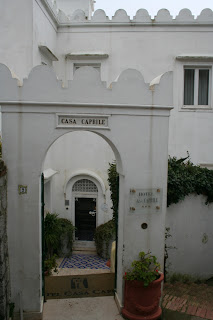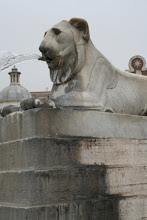

On Saturday our suitcases are lugged up to the waiting taxi and we drive down to Capri's Marina Grande in plenty of time for our 11.35am hydrofoil to Naples. Everything runs smoothly this time - the crossing is calm, the taxis are back in action and our train to Caserta is on time. At Caserta we change to the Eurostar train and we are taking this trip all the way to the terminus at Lecce.
Lecce is in the region of Puglia - right in the 'heel' of Italy. The journey is about 5 hours, and we pass through flat, fertile (and at times flooded) farmland. We spy the Barilla pasta factory at Incorata and wonder if the major producer for the Company - must look it up when we get home. We are always loyal to Barilla pasta!
Around 8pm we arrive at Lecce, having passed through the major ports of Brindisi and Bari. Our taxi takes us through crowds of Saturday-night strollers and we slowly inch, and toot, our way towards the hotel.
The Palazzo Rollo is glorious. We enter through a wide wooden portal and ascend marble steps to our room. We pass through mosaic-floored, oriental-carpeted magnificent rooms. Our room is completely charming with high arched ceiling, tall shuttered windows overlooking a central court, and sumptous draperies. It's truly lovely and our hostess has already set a breakfast table overlooking the courtyard.
Lecce feels not quite Italian. There are greek, Norman and arabic influences in the architecture and the predominantly local stone is sepia or sandy-toned. Iron balconies are supported by ornate sculpted pillasters and there are carved lintels above the doorways. Streets are wide and it's all very clean. We take a walk with the evening crowd; buskers are playing street music and there are night vendors selling jewelery and leather-work.
We read later that the region of Puglia is not heavily geared towards tourism, and there's a take-us-as-you-find-us attitude that's initially challenging. The next day we take a walk outside the historic centre and find a small market where there's a mixture of locally made and locally grown goods. I buy a huge salad bowl to lug home on my carry-on luggage. We also buy blood oranges (we're going to miss these oranges) and browse through some of the artisan shops near the centre.
We stop by the museum and explore the ancient Roman theatre. We climb the steps up to the top level and look down to the stage. The modern buildings have encroached on the ruins and we are hemmed in on all sides by baroque architecture. The sun is blazing overhead today, and its warm enough to shed our coats. We find an outdoor wine cafe close to our hotel and share some local food and wine in the sunshine. Today it feels truly as if we're on holiday and we sit happily enjoying a leisurely lunch. A highlight is the Leccese olive oil and vincotto. We mop up lots of this with bread. Jim is drinking a regional red wine and I'm on my second glass of prosecco.
Tomorrow we head back to Rome for a couple of days before flying out on Friday. Part of me is sorry to be leaving a country that has alternated between being extremely welcoming and accommodating, and somewhat challenging as we've travelled further south. I'm feeling excited at the prospect of being home and seeing our friends and beloved menagerie again, and spending some time in the warmth before the onset of autumn. We discuss the need for space and an identity; something that can be difficult to maintain after time in a crowded and alien place.
Lecce is in the region of Puglia - right in the 'heel' of Italy. The journey is about 5 hours, and we pass through flat, fertile (and at times flooded) farmland. We spy the Barilla pasta factory at Incorata and wonder if the major producer for the Company - must look it up when we get home. We are always loyal to Barilla pasta!
Around 8pm we arrive at Lecce, having passed through the major ports of Brindisi and Bari. Our taxi takes us through crowds of Saturday-night strollers and we slowly inch, and toot, our way towards the hotel.
The Palazzo Rollo is glorious. We enter through a wide wooden portal and ascend marble steps to our room. We pass through mosaic-floored, oriental-carpeted magnificent rooms. Our room is completely charming with high arched ceiling, tall shuttered windows overlooking a central court, and sumptous draperies. It's truly lovely and our hostess has already set a breakfast table overlooking the courtyard.
Lecce feels not quite Italian. There are greek, Norman and arabic influences in the architecture and the predominantly local stone is sepia or sandy-toned. Iron balconies are supported by ornate sculpted pillasters and there are carved lintels above the doorways. Streets are wide and it's all very clean. We take a walk with the evening crowd; buskers are playing street music and there are night vendors selling jewelery and leather-work.
We read later that the region of Puglia is not heavily geared towards tourism, and there's a take-us-as-you-find-us attitude that's initially challenging. The next day we take a walk outside the historic centre and find a small market where there's a mixture of locally made and locally grown goods. I buy a huge salad bowl to lug home on my carry-on luggage. We also buy blood oranges (we're going to miss these oranges) and browse through some of the artisan shops near the centre.
We stop by the museum and explore the ancient Roman theatre. We climb the steps up to the top level and look down to the stage. The modern buildings have encroached on the ruins and we are hemmed in on all sides by baroque architecture. The sun is blazing overhead today, and its warm enough to shed our coats. We find an outdoor wine cafe close to our hotel and share some local food and wine in the sunshine. Today it feels truly as if we're on holiday and we sit happily enjoying a leisurely lunch. A highlight is the Leccese olive oil and vincotto. We mop up lots of this with bread. Jim is drinking a regional red wine and I'm on my second glass of prosecco.
Tomorrow we head back to Rome for a couple of days before flying out on Friday. Part of me is sorry to be leaving a country that has alternated between being extremely welcoming and accommodating, and somewhat challenging as we've travelled further south. I'm feeling excited at the prospect of being home and seeing our friends and beloved menagerie again, and spending some time in the warmth before the onset of autumn. We discuss the need for space and an identity; something that can be difficult to maintain after time in a crowded and alien place.











